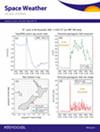An Improved Stochastic Model for the Geodetic GNSS Receivers Under Ionospheric Scintillation at Low Latitudes
IF 3.7
2区 地球科学
引用次数: 0
Abstract
The receiver tracking error stochastic (RTES) model can improve GNSS precise point positioning (PPP) performance under ionospheric scintillation. However, it relies on scintillation products derived from ionospheric scintillation monitoring receivers (ISMRs), which means the RTES model cannot be used for abundant geodetic GNSS receivers. In this study, we propose an improved RTES, referred to as Impr_RTES model, to mitigate scintillation effects on geodetic GNSS receivers at low latitudes, where severe scintillation frequently occurs. In the Impr_RTES model, the tracking error variances at the output of code delay locked loop are calculated by using the index S4c, and these of phase locked loop are modeled by using the rate of total electron content index (ROTI) and S4c. Both S4c and ROTI can be derived from geodetic GNSS receivers. The performance of the Impr_RTES model is validated by using the data sets from ISMR and geodetic receivers, respectively. Using one month of GPS data collected at HNLW station installed with ISMR in Hainan of China from 1 to 28 February in 2023, statistical results indicate that the PPP solution based on Impr_RTES model can improve the positioning accuracy by approximately 22.6%, 23.8%, and 30.2% in the east, north, and up directions, respectively, over the elevation angle stochastic (EAS) model. Meanwhile, the positioning performance of Impr_RTES PPP is comparable to that of RTES PPP. For the GPS data from geodetic receivers, experimental results suggest that compared with EAS, the Impr_RTES model can obviously mitigate scintillation effects on PPP.低纬度电离层闪烁条件下大地测量全球导航卫星系统接收器的改进随机模型
接收器跟踪误差随机(RTES)模型可以改善电离层闪烁情况下的全球导航卫星系统精确点定位(PPP)性能。然而,该模型依赖于电离层闪烁监测接收机(ISMR)产生的闪烁产品,这意味着 RTES 模型不能用于丰富的大地测量 GNSS 接收机。在本研究中,我们提出了一种改进的 RTES(称为 Impr_RTES 模型),以减轻对经常发生严重闪烁的低纬度地区大地测量 GNSS 接收器的闪烁影响。在 Impr_RTES 模型中,代码延迟锁定环路输出端的跟踪误差方差通过指标 S4c 来计算,而相位锁定环路的跟踪误差方差则通过总电子含量速率指标(ROTI)和 S4c 来建模。S4c 和 ROTI 都可以从大地测量全球导航卫星系统接收器中获得。分别使用 ISMR 和大地测量接收器的数据集验证了 Impr_RTES 模型的性能。统计结果表明,基于 Impr_RTES 模型的 PPP 方案在东、北、上三个方向的定位精度比仰角随机(EAS)模型分别提高了约 22.6%、23.8% 和 30.2%。同时,Impr_RTES PPP 的定位性能与 RTES PPP 相当。对于大地测量接收机的 GPS 数据,实验结果表明,与 EAS 相比,Impr_RTES 模型能明显减轻闪烁对 PPP 的影响。
本文章由计算机程序翻译,如有差异,请以英文原文为准。
求助全文
约1分钟内获得全文
求助全文

 求助内容:
求助内容: 应助结果提醒方式:
应助结果提醒方式:


